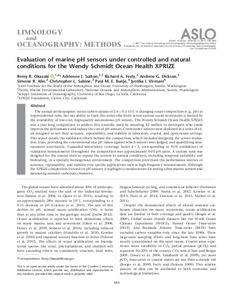| dc.contributor.author | Okazaki, Remy R. | |
| dc.contributor.author | Sutton, Adrienne J. | |
| dc.contributor.author | Feely, Richard A. | |
| dc.contributor.author | Dickson, Andrew G. | |
| dc.contributor.author | Alin, Simone R. | |
| dc.contributor.author | Sabine, Christopher L. | |
| dc.contributor.author | Bunje, Paul M. E. | |
| dc.contributor.author | Virmani, Jyotika I. | |
| dc.date.accessioned | 2019-01-10T15:28:03Z | |
| dc.date.available | 2019-01-10T15:28:03Z | |
| dc.date.issued | 2017 | |
| dc.identifier.citation | Okazaki, R. R.; Sutton, A. J.; Feely, R. A.; Dickson, A. G.; Alin, S. R.; Sabine, C. L.; Bunje, P. M. and Virmani, J. I. (2017) Evaluation of marine pH sensors under controlled and natural conditions for the Wendy Schmidt Ocean Health XPRIZE. Limnology and Oceanography: Methods, 15, pp.586-600. DOI:10.1002/lom3.10189 | en_US |
| dc.identifier.uri | http://hdl.handle.net/11329/641 | |
| dc.identifier.uri | http://dx.doi.org/10.25607/OBP-200 | |
| dc.description.abstract | The annual anthropogenic ocean carbon uptake of 2.6 plus or minus 0.5 Gt C is changing ocean composition (e.g., pH) at
unprecedented rates, but our ability to track this trend effectively across various ocean ecosystems is limited by
the availability of low-cost, high-quality autonomous pH sensors. The Wendy Schmidt Ocean Health XPRIZE
was a year-long competition to address this scientific need by awarding $2 million to developers who could
improve the performance and reduce the cost of pH sensors. Contestants’ sensors were deployed in a series of trials designed to test their accuracy, repeatability, and stability in laboratory, coastal, and open-ocean settings.
This report details the validation efforts behind the competition, which included designing the sensor evaluation trials, providing the conventional true pH values against which sensors were judged, and quantifying measurement uncertainty. Expanded uncertainty (coverage factor k 5 2, corresponding to 95% confidence) of
validation measurements throughout the competition was approximately 0.01 pH units. A custom tank was
designed for the coastal trials to expose the sensors to natural conditions, including temporal variability and
biofouling, in a spatially homogenous environment. The competition prioritized the performance metrics of
accuracy, repeatability, and stability over specific applications such as high-frequency measurements. Although
the XPRIZE competition focused on pH sensors, it highlights considerations for testing other marine sensors and
measuring seawater carbonate chemistry. | en_US |
| dc.language.iso | en | en_US |
| dc.rights | Attribution 4.0 | * |
| dc.rights.uri | http://creativecommons.org/licenses/by/4.0/ | * |
| dc.subject.other | pH | en_US |
| dc.title | Evaluation of marine pH sensors under controlled and natural conditions for the Wendy Schmidt Ocean Health XPRIZE. | en_US |
| dc.type | Journal Contribution | en_US |
| dc.description.refereed | Refereed | en_US |
| dc.format.pagerange | pp.586-600 | en_US |
| dc.identifier.doi | 10.1002/lom3.10189 | |
| dc.subject.parameterDiscipline | Parameter Discipline::Chemical oceanography | en_US |
| dc.subject.instrumentType | Instrument Type Vocabulary::pH sensors | en_US |
| dc.bibliographicCitation.title | Limnology and Oceangraphy: Methods | en_US |
| dc.bibliographicCitation.volume | 15 | en_US |
| dc.description.sdg | 14.3.1 | |
| dc.description.bptype | Best Practice | en_US |
| dc.description.bptype | Guide | en_US |
| obps.contact.contactemail | Remy.Okazaki@noaa.gov | |
| obps.resourceurl.publisher | https://aslopubs.onlinelibrary.wiley.com/doi/full/10.1002/lom3.10189 | en_US |
 Repository of community practices in Ocean Research, Applications and Data/Information Management
Repository of community practices in Ocean Research, Applications and Data/Information Management

